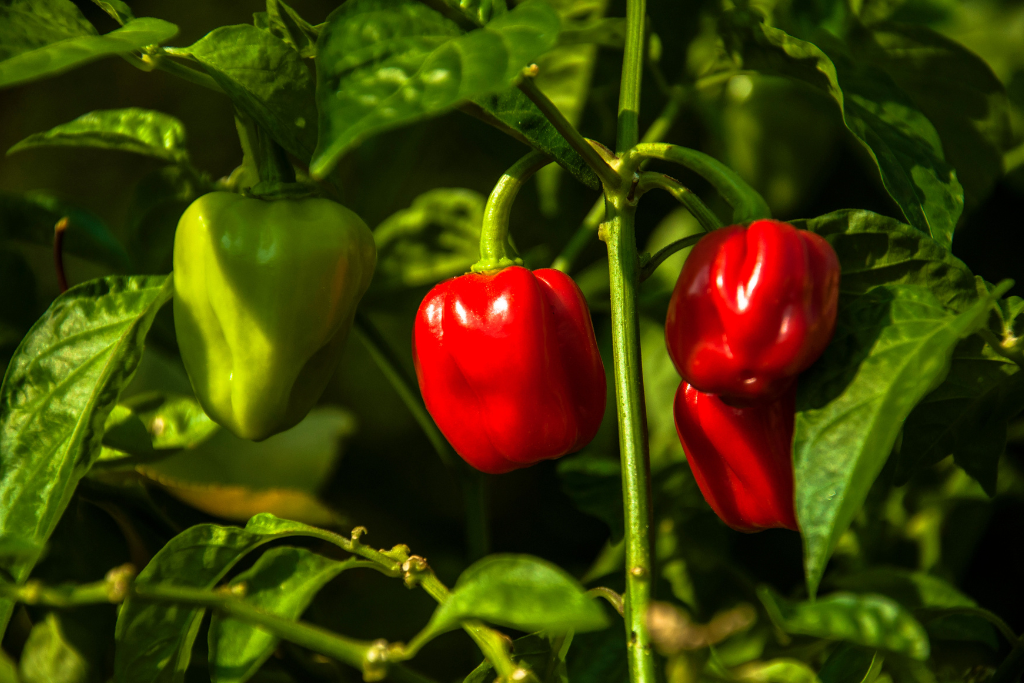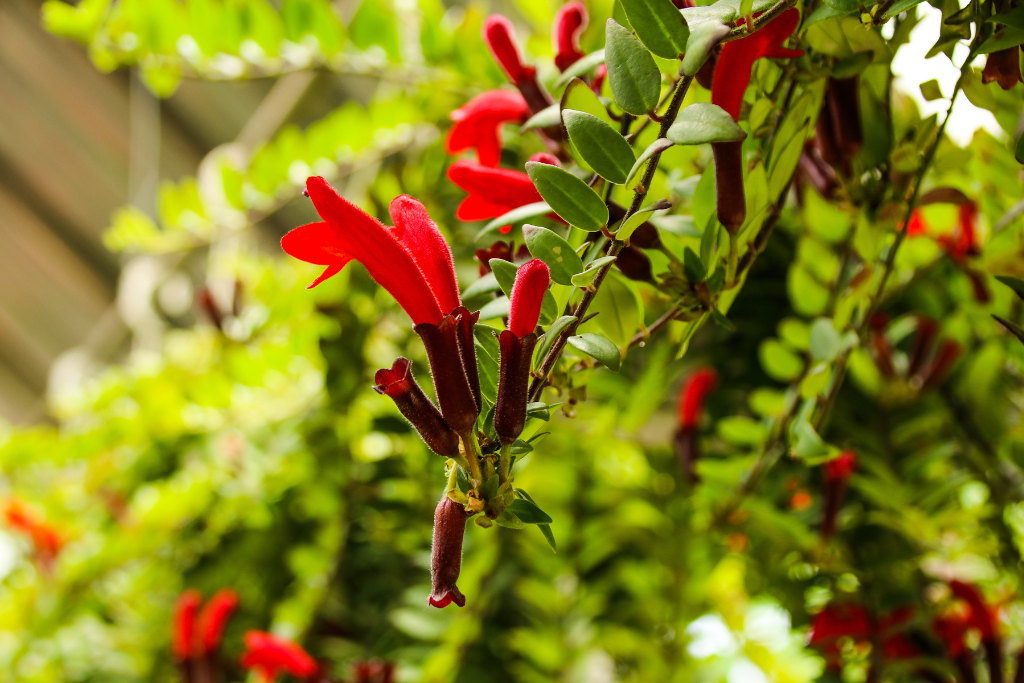
I consider myself quite lucky to have a friend who often shares her farm-grown ginger with me when see each other at the farmer’s market.
Maybe this wouldn’t be such a fantastic gift to some people, but I think it’s pretty cool.
Up until the point she first gifted me a little nub of ginger root, I was totally unaware it was possible to grow ginger in our area. New England seasons are a bit different than the tropical climates where ginger thrives and hails from.
On their farm, they grow ginger in big pots inside their greenhouses. It’s a fascinating process and they produce some rather large, tasty roots. There’s nothing like freshly pulled ginger root!
Even with my affinity for this locally cultivated ginger, I’ve never given much thought as to which plants make good companions for this South Asian native root.
Read along as we discuss the best plants to grow alongside your ginger root and how they will increase the biodiversity and overall resilience of your garden. This season I hope to cultivate my own ginger and then share some of these valuable tips with my ginger-growing friend!
Ginger as a Companion Plant
As an exotic, tropical flowering plant ginger doesn’t seem like it would pair well with our familiar, standard garden fruits and veggies. Yet when we dig deeper, it seems ginger shares symbiotic relationships with plenty of traditionally grown crops.
Ginger requires some specific conditions to grow and thrive, and that’s precisely where companion plants come in. It benefits from the shade of taller plants and enjoys the introduction of beneficial insects from other garden crops. Ginger, in its own right, is also known to repel pests due to its spicy aroma. When planted with the right companions, ginger contributes a good deal to a healthy garden space.
Beans and Peas
Bush and pole beans and peas are great company for your ginger plant. They either grow stout or tall, so can be planted in a way that shades your ginger best.
Legumes like beans and peas deposit nitrogen into the soil, aiding vegetative growth. This is especially beneficial for a crop like ginger. The long growing season of ginger can lead to meager harvests in colder regions. But with an influx of nitrogen, the greens above ground will be encouraged to grow rapidly, leading to bigger roots come harvest time.
Chili Peppers
When hot pepper plants are maturing and reach their peak height in the middle of the hot summer season is about the same time that ginger really needs some relief from the sun. The sky-reaching chili pepper plants provide an abundance of shade while gratefully accepting the pest-repelling abilities of ginger. The shade from closely planted ginger leaves can also help to keep chili pepper roots cool.

Nasturtium
The perfect trap crop, nasturtium will creep along the ground and act as a distracting border patrol for your ginger. It has the ability to repel some pests, but oftentimes nasturtium is heavily attacked by aphids. It’s an effective way to keep the annoying pests from bothering your ginger.
The crawling nasturtium stems, leaves and flowers do a great job of keeping conditions cool for ginger roots.
Garlic
One of the best alliums to grow as a companion plant is garlic. The roots need very little space to mature and size up, fitting in nicely with the growing habits of ginger. The pungent smell of garlic drives away many pests and its antifungal properties can even help prevent the spread of some soil-borne diseases.
The enhanced flavor of both of the root crops is the result of growing ginger and garlic together. They accompany each other well not only in the field but as culinary ingredients as well.
Fruit Trees
Ginger will benefit significantly from the natural height of fruit trees. Branches full of foliage and fruit will provide all the summertime shade anybody could ask for.
Ginger in turn will help deter some of the many pests that typically pester fruit trees. This unlikely combo will grow happily alongside one another until harvest time in the fall.
Lemongrass
These two tropical plants really enjoy each other’s company. Their growing styles and needs don’t conflict; together, ginger and lemongrass are an unbeatable team when it comes to repelling annoying pests like mosquitoes.
Tall blades of lemongrass will support the growth of ginger by giving it plenty of shade.
Also, I can’t help to mention the wonderful pairing ginger and lemongrass make in all manner of recipes.

Cilantro
The green, aromatic leaves of cilantro are a blessing to any garden space. Their leaves and tiny white flowers attract beneficial pollinators and pest predators. You will see a reduction in pests and observe a boost in plant health and yield due to pollinator activity when cilantro is planted close by.
As cilantro matures, its leaves sprawl and do an excellent job of shading the surrounding area. Your ginger will gladly accept the cooling relief from the sun that this companion herb provides.
Turmeric
Ginger and turmeric are like two peas in a pod. Actually, more like two roots in the dirt. Anyway, the analogy holds up.
Taking care of ginger and turmeric together is a simple task. The two roots won’t compete for nutrients or space and require the same growing conditions. They can improve the flavor and aroma of each other when grown in close proximity. Expect a tasty, bountiful crop of health-giving roots when ginger and turmeric are grown together.
Because they both fall victim to the same types of pests, it would be wise to accompany them with another pest-repelling companion plant like cilantro or garlic.

Spinach
Ginger’s natural pest-repelling abilities will help drive off common spinach pests. In exchange for this favor, broad spinach leaves will shelter ginger roots from the hot mid-day sun.
The scent ginger emits helps ward off deer from nibbling on all types of greens and brassicas.
Find out more about spinach companion plants here.
What NOT to Plant With Your Ginger
It’s important to be aware that ginger doesn’t grow well alongside all types of plants. Here’s a shortlist of what not to grow close to your ginger.
Tomatoes and Eggplant
While peppers and ginger get along great, other nightshades like tomatoes and eggplant should not share the same soil as ginger. The chemical compounds of tomatoes and eggplant can cause bacterial wilt in your ginger. This unpleasant disease should be avoided by at least keeping all of these plants in separate containers.
Walnut Trees
Ginger should never be planted near walnut trees. A toxic chemical released by walnut trees called juglone makes it a terrible companion to most plants. This soil-borne chemical will kill your ginger plant in no time.
Full Shade Trees
Ginger shouldn’t be grown next to any tree, shrub or hedge that casts full shade all day long. As much as ginger appreciates cool soil and relief from the heat, it does require some sunshine to grow productively.
Study how the sun moves over your property and study the shadows. It’s best to plant ginger where it will receive early morning or late afternoon sun while being protected during the hottest hours of the day.
Ginger Is an Easy-Going Neighbor
There really aren’t any drawbacks to growing ginger as a companion plant if you keep it away from the few exceptions.
Ginger is low-maintenance, has pest-repelling qualities and occupies little space. Due to its short overall stature, ginger grows splendidly under the canopies of taller bushes and trees. And because it isn’t demanding of soil types, ginger makes an easy-going neighbor for just about any garden plant.
Frequently Asked Questions (FAQ)
Does ginger grow best in sun or shade?
In cool climates, ginger stands up well to full sun. In cold regions, plant it in containers so it can be moved to shade during heat waves or indoors when an early frost threatens. Ginger needs some daytime shade in hot, tropical climates.
Can ginger be overwintered outdoors?
In tropical regions, ginger is a perennial that will reliably sprout up every spring. In colder climates, ginger has to be harvested before a frost or planted in a container that can be brought indoors. Ginger will perish when exposed to temperatures lower than 20 degrees.
How long does it take for ginger to mature?
Ginger requires 210-240 growing days to reach maturity. If the root is going to be used immediately, ginger can be harvested at around 180 days. If you plan on drying the root, wait until the leaves die off, a good indicator of full maturity.
Can you eat ginger leaves?
Concerning common, culinary ginger; the answer is yes! The leaves and shoots are edible. They have a milder flavor than the root itself and can be added to many dishes to impart a gentle ginger flavor.



